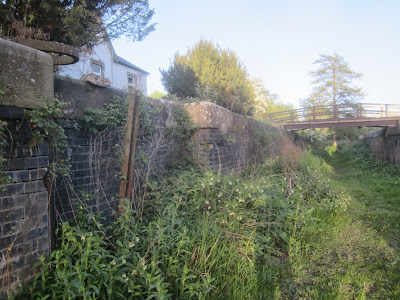 |
| Lower Parting where the two channels of the river meet again |
A couple of hours later we bumped into Anthony, its skipper, who it turns out moors down the canal at Saul; so maybe not such a surprise to find him there. Meeting him changed our plans for the day as he told us of some interesting walks around Alney Island, the nature reserve on the other side of the river from the docks. So, after a morning's wander round Gloucester's shops - a decidedly unlovely clutch of 1960s and 70s precincts sadly - we headed across the footbridge from the Dock to the island.
 |
| Ships masts rise above dock buildings - a view unchanged for 150 years |
We walked round the southern edge of the island, following the river and looked back across at the docks where tall masts stood out between the old brick buildings in a view that has been unchanged for 150 years. We were looking out for the remains of Llanthony Lock, which was built to by-pass the river weir and give an alternative route to the rest of the river to boats that didn't want to pay the canal dues. It was in service from 1871 until 1924 when its walls started to move inwards. But it's still there, remarkably complete, and even has a lock house that's occupied.
 |
| Llanthony Lock: when restored it will be the gateway to a revived canal |
We followed the route they will take to Lower Parting, a glorious spot where the two channels meet and the river, now wide and magnificent again, flows on. It's a wonderfully remote place, with fine views – and to see the Severn Bore racing up towards you there must be a great sight.
A father and young son were fishing – for sea bass. Now that's what I call angling; catching fish you can take home and eat.
We headed north up the side of the western channel towards the huge modern road bridge that takes the A40 from Gloucester to Wales. Beside it is the railway bridge and sandwiched between them an single arched stone bridge whose classic proportions could only have been designed by one man – yes, it's that chap Thomas Telford once more.
 |
| Another great Telford bridge once spanned the Severn as the main road to Wales |
We walked across, ducked under the big new bridge and turned off the river path to see if we could discover the start of the Herefs & Gloucs Canal. And it was quite a surprise to clamber up the bank and find, not a damp ditch, but a fully finished canal basin, all pristine, smart, in water and even with a cluster of boats able to ply the half mile length that's in water. There's even a Wharf House visitor centre though that was shut by the time we got there.
 |
| The basin of the Herefs & Gloucs Canal - all built by volunteer labour |
Today we've moved on from the Docks: our 48 hours is up and we are moored out in the country now ready for a weekend of grandparent duties way across country in Suffolk. Back blogging next week.
 |
| The bridge lifts and we have to leave the wonderful Docks behind |
No comments:
Post a Comment